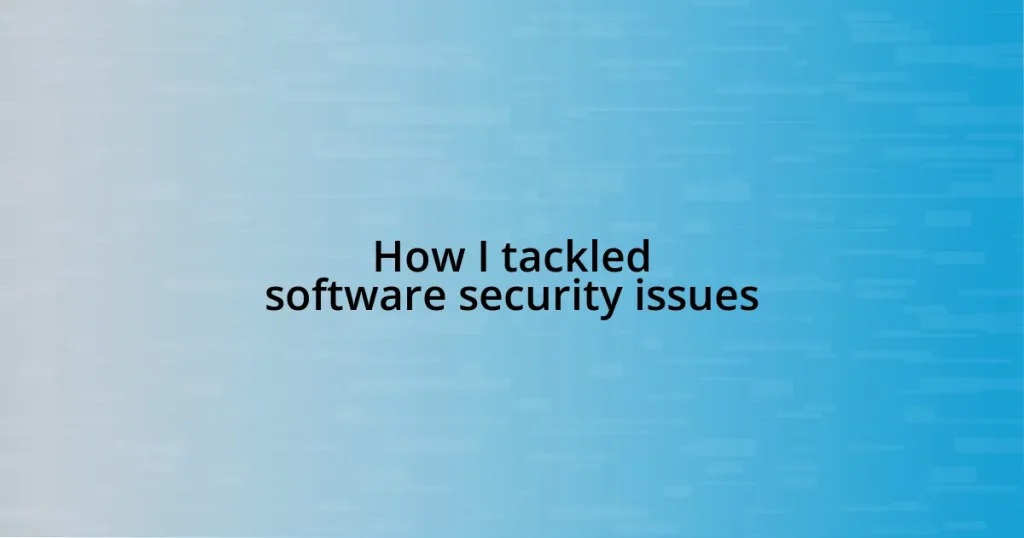Key takeaways:
- Identifying security issues often begins with intuition and vigilance for red flags, such as outdated libraries and unusual patterns in user behavior.
- Implementing a culture of security awareness through regular training, code reviews, and collaborative auditing fosters shared responsibility among team members.
- Integrating automated security tools enhances vulnerability detection but should be supplemented by human judgment and intuition for comprehensive security practices.
- Evaluating security incident responses through open dialogue and actionable insights helps build a resilient team capable of future challenges.
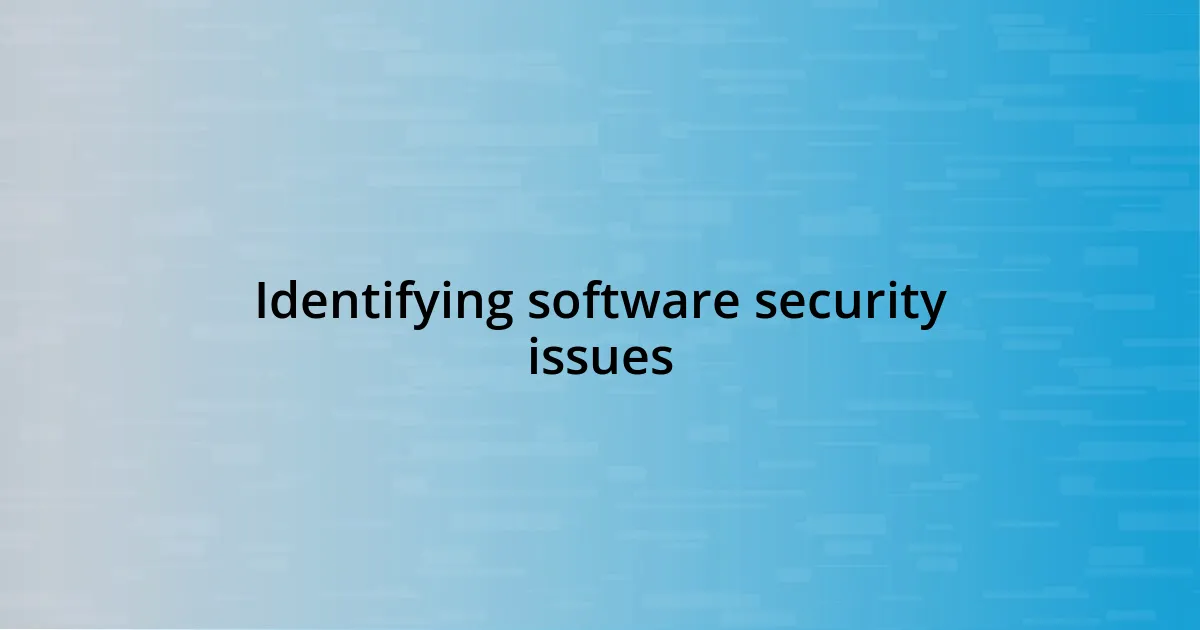
Identifying software security issues
Identifying software security issues often starts with a gut feeling—somewhere deep down, I just know something isn’t quite right. I recall working late one night when I stumbled across an unusual spike in API requests during a routine code review. This anomaly prompted me to dig deeper, leading to the discovery of a vulnerability that could have easily gone unnoticed.
In my experience, staying vigilant for common red flags is crucial. One time, I noticed some outdated libraries we were using in a project. It felt like a ticking time bomb, knowing that unpatched software is one of the leading causes of security breaches. This realization drove me to implement regular dependency checks, ensuring we were always aligned with the latest security protocols.
It’s also essential to foster a culture of open communication within the team. When developers feel comfortable discussing potential security flaws, it’s amazing what we can uncover together. Have you ever had a colleague who pointed out something you missed? I remember a junior developer highlighting a potential injection flaw during a code walkthrough. That moment not only made me appreciate diverse perspectives but also solidified the importance of collaborative vigilance in identifying security issues.
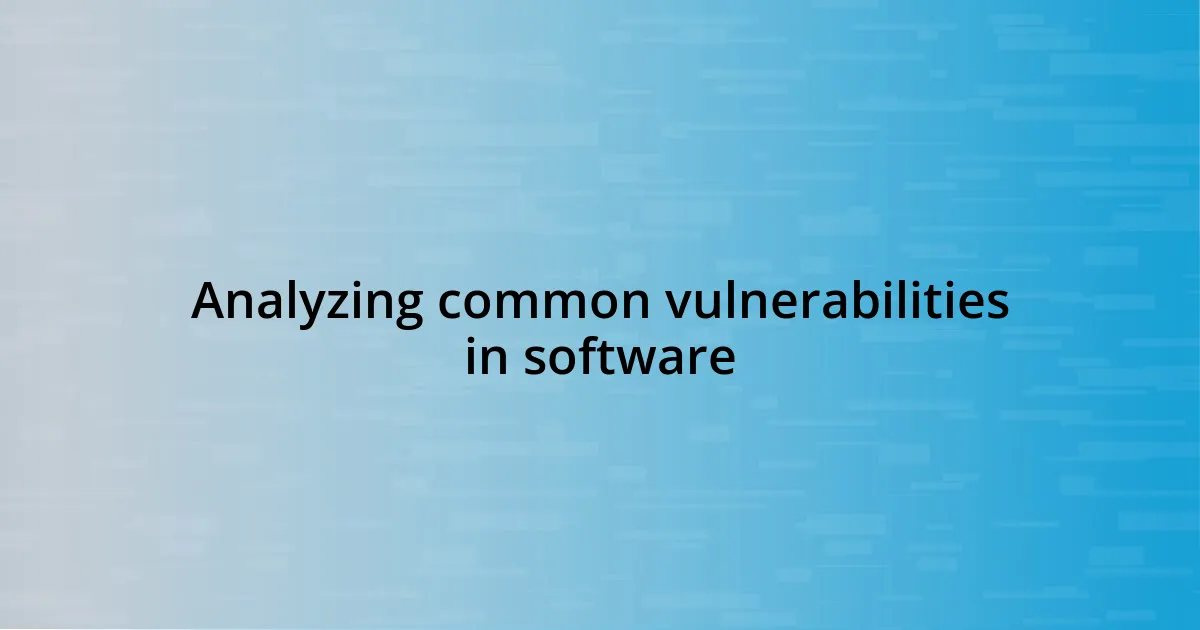
Analyzing common vulnerabilities in software
Analyzing common vulnerabilities in software is a crucial aspect of maintaining security. I frequently encountered issues like SQL injection and cross-site scripting during my development journey. One memorable project involved a customer dashboard where I found SQL injection vulnerabilities after running a security scan. It was sobering to realize that a simple oversight in input validation could expose sensitive user data. That discovery reinforced my belief in incorporating automated tools during the testing phase.
Sometimes, these vulnerabilities stem from more than just coding errors; they arise from misconfigured settings. During a project where we employed cloud services, I discovered that default configurations were still in use. I felt a sense of urgency surge within me as I recognized that it was an easy fix but equally a critical point of failure. Addressing these default settings became a priority after witnessing how swiftly a compromised environment could lead to broader security issues.
Additionally, I learned that understanding user behavior can reveal unexpected vulnerabilities. While monitoring application logs, I observed unusual patterns in how users interacted with our software. This analysis not only led to identifying weaknesses in session management but also illuminated an opportunity for improving user experience. It became clear to me that security is not just a technical issue; it’s about understanding how users interact with the system and addressing their pain points.
| Vulnerability Type | Description |
|---|---|
| SQL Injection | A technique where an attacker manipulates queries to access or alter data in a database. |
| Cross-Site Scripting (XSS) | This vulnerability allows attackers to inject malicious scripts into webpages viewed by others, leading to data theft. |
| Default Configuration Issues | Failing to change factory defaults may leave systems exposed to attacks, exploiting known vulnerabilities. |
| Session Management Flaws | Issues related to handling user sessions can lead to unauthorized access and session hijacking. |
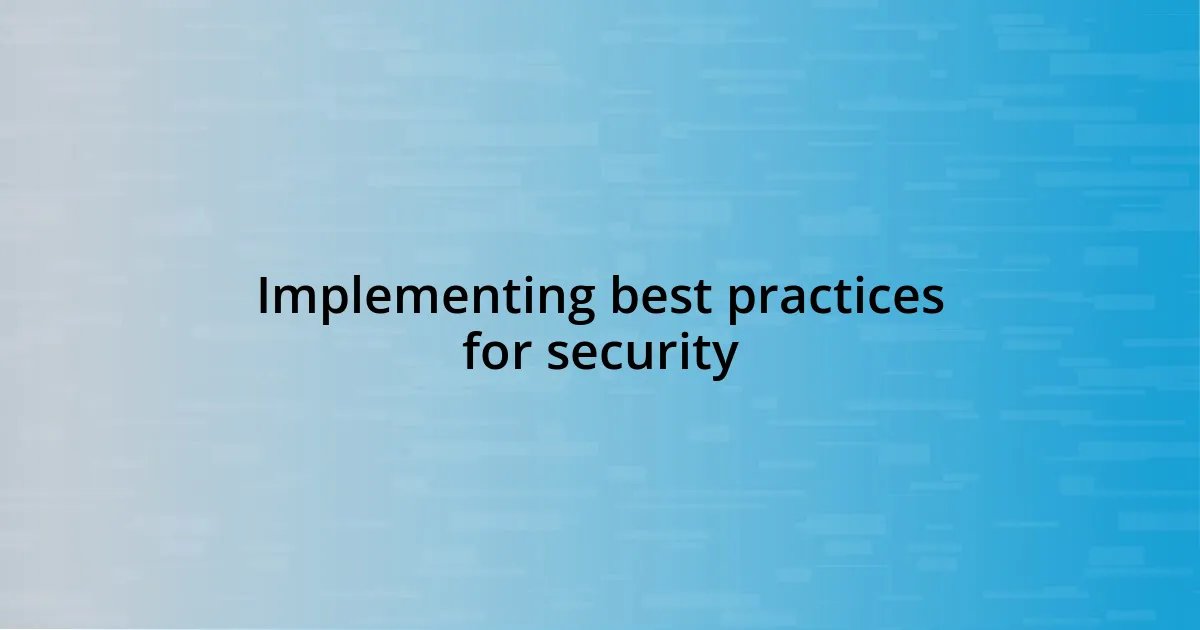
Implementing best practices for security
Implementing best practices for security is paramount in building resilient software. I find that establishing a robust security mindset among the development team truly transforms our approach. During one project, I led a workshop focused on security awareness, and the energy in the room was palpable. It was rewarding to see my colleagues become more proactive in identifying potential issues, like how one developer instinctively started auditing code for vulnerabilities before submitting changes, showcasing the cultural shift I had hoped for.
To ensure that security best practices are integrated effectively, I recommend focusing on the following key areas:
- Regular Security Training: Equip the team with up-to-date knowledge on the latest security trends and techniques.
- Code Reviews with a Security Lens: Encourage developers to scrutinize each other’s work not just for functionality but also for security implications.
- Implement Security Testing Tools: Use automated tools to identify vulnerabilities early in the development cycle, reducing the potential for issues to affect production.
- Maintain Up-to-Date Dependencies: Continuously audit libraries and frameworks to ensure they are the most secure versions.
- Establish Incident Response Plans: Being prepared for breaches is as crucial as preventing them; having a clear plan helps mitigate panic and confusion.
These practices have not only bolstered our defense against attacks but also cultivated a collaborative environment where everyone feels responsible for the security of our software. It’s incredible how much more engaged the team becomes when security is woven into the very fabric of our processes.
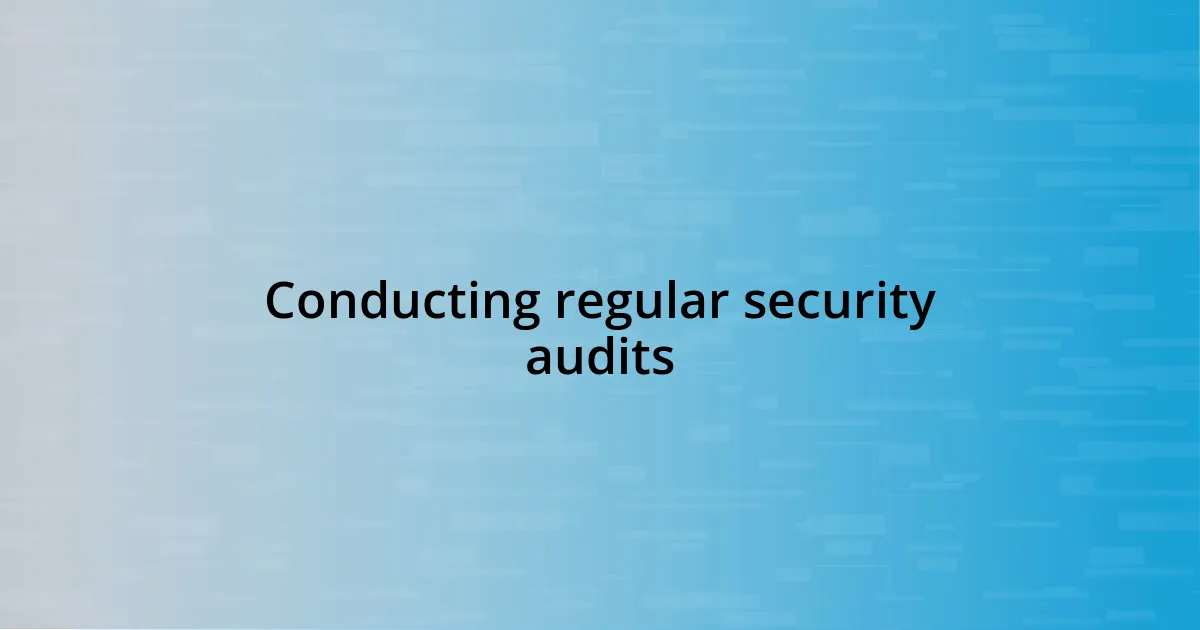
Conducting regular security audits
Conducting regular security audits has been one of the most effective measures I implemented in my development journey. I remember one particular instance where we discovered a vulnerable API endpoint during a routine check. It was a wake-up call to learn that, without consistent audits, we might have left an open door for attackers. The relief I felt when we identified and patched the vulnerability reinforced the importance of proactive security measures.
I also found that involving the entire team in the auditing process created a sense of shared responsibility. During one audit, a junior developer pointed out an ineffective authentication flow that I had overlooked. I couldn’t help but feel a swell of pride as they took the initiative, demonstrating their understanding of security principles. This collective approach not only uncovered critical issues but also fostered a culture where everyone was vigilant and engaged in safeguarding our software.
Regular audits can seem daunting, but I’ve learned to integrate them into our development cycle seamlessly. Instead of viewing audits as a chore, I invite the team to treat them as an opportunity for growth. Each audit reveals not just vulnerabilities but also areas for improvement. Reflecting on how our practices evolved over time makes me wonder—how can we continually adapt to the changing landscape of security threats? Embracing regular audits has helped us stay ahead, ensuring that our software remains robust in the face of evolving challenges.
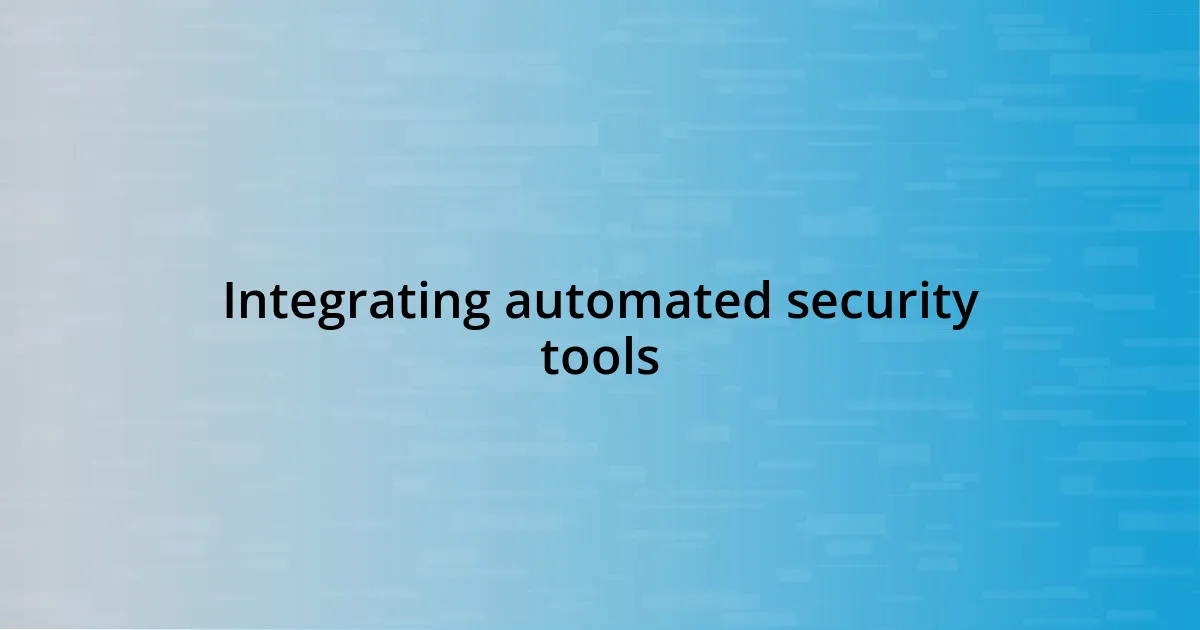
Integrating automated security tools
Integrating automated security tools has been a game-changer for my development process. When I first adopted tools like static application security testing (SAST) and dynamic application security testing (DAST), I was struck by how much they could uncover. In one instance, a tool flagged a critical vulnerability I had completely overlooked. It was a moment of both panic and relief; panic because of the potential risk, but relief because we caught it early enough to fix it before it reached production.
What I’ve found is that these tools not only streamline the identification of vulnerabilities but also save time during the development cycle. I remember setting up an automated scanning tool that would run with every pull request. The immediate feedback it provided was invaluable—more often than not, it prompted discussions among team members about security considerations we hadn’t previously prioritized. Watching my colleagues engage in these discussions felt like the seeds of a security-first culture were finally taking root.
I often wonder, can we rely entirely on automated tools? While they are essential for efficiency, I believe they should complement—not replace—human judgment. During a project involving sensitive data, I saw firsthand the limitations of automation when we missed a sneaky business logic vulnerability. It made me realize that, while tech can assist in our security efforts, nothing can replace the intuition and creativity of an engaged team. Ultimately, integrating these tools has been about enhancing our capabilities while reminding ourselves that security is a shared responsibility that thrives on both technology and human insight.
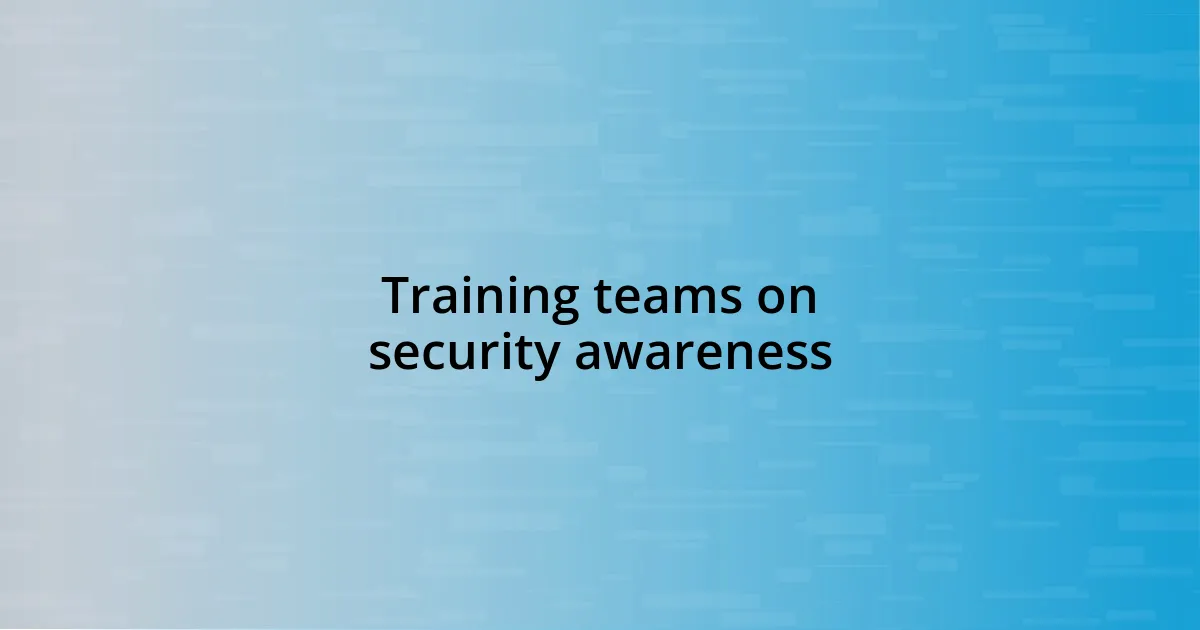
Training teams on security awareness
Training teams on security awareness is essential for cultivating a security-first mindset. I’ll never forget a workshop I attended where a cybersecurity expert shared haunting statistics about insider threats. It hit home for me, as I realized that even well-intentioned team members could inadvertently compromise our projects. This revelation led me to develop tailored training sessions that emphasize real-world scenarios, sparking discussions that often reveal overlooked vulnerabilities within our own practices.
One effective strategy I adopted was to incorporate gamified training sessions, which transformed the learning process into an engaging experience. I recall a session where we divided into teams to resolve simulated security breaches. The friendly competition created an energy that had everyone actively participating. It was brilliant to see my colleagues brainstorm solutions, and the way the dynamics shifted made it clear: security awareness wasn’t just about policies; it became a part of our culture. How often do we overlook opportunities to make learning enjoyable?
Finally, I remember gathering feedback after our security training and being surprised by the eagerness to learn more among my teammates. They expressed a desire for ongoing sessions, wanting to keep security top of mind as we navigated our projects. This feedback reinforced my belief that continuous education fosters an environment where we not only identify security risks but also feel empowered to tackle them together. It’s become clear to me that investing in my team’s awareness is not just about protecting our software—it’s about building a community that feels responsible for our shared security.
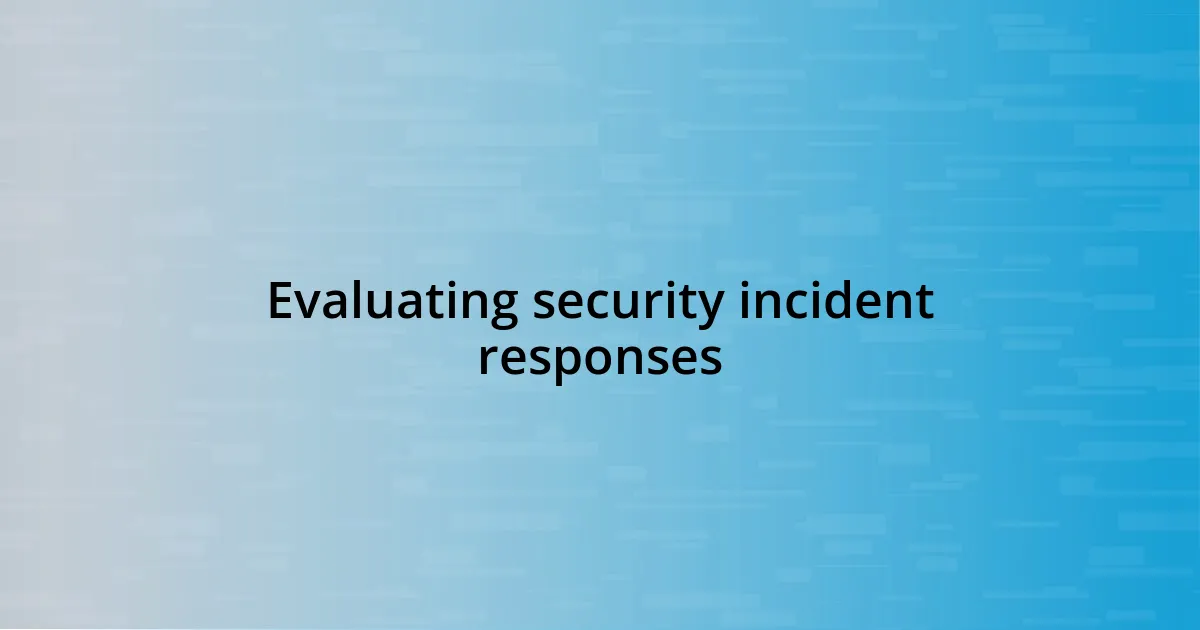
Evaluating security incident responses
Evaluating security incident responses requires a thorough understanding of what went wrong and how we can learn from it. I distinctly remember a particularly challenging incident where a data breach occurred due to a misconfigured server. Reflecting back, we set up a retrospective meeting where we not only identified the gaps in our response but also celebrated how swiftly our team adapted and contained the issue—there’s something really powerful about acknowledging both the good and the bad in a stressful situation.
One key takeaway from evaluating our responses has been the importance of action items. After every incident, I make it a point to compile a list of actionable steps we can take moving forward. For instance, after one incident, we realized that our communication channels were lacking during the crisis. I looked back and thought, wouldn’t it be beneficial to have a real-time collaboration tool specifically for incidents? That adjustment alone transformed how we handled issues going forward, fostering a sense of unity among the team when it mattered most.
I also find it invaluable to encourage an open dialogue about responses. During a casual lunch meeting, I asked my colleagues how they felt we did following our last security incident. As we shared our thoughts, I noticed several people acknowledging both personal and team-level contributions that made a real difference. It was heartening to see how much they cared and how willing they were to engage in improvement. Have you ever experienced that moment when a seemingly small change leads to a significant impact? That’s the kind of growth I strive for in our security practices. It’s clear to me now: each review of our responses isn’t just about identifying mistakes—it’s about building a resilient team capable of facing whatever challenges come next.










